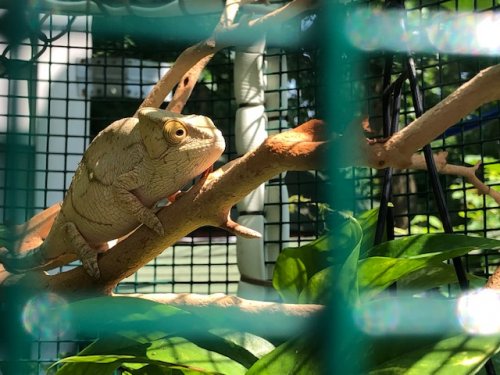Question 1: How hot is really too hot for a Parsons?
I've been keeping my 6-7 month old female orange eye outside now for more than a month here in the mid-Atlantic US, and its starting to get really hot. I plan to keep her outside for the whole summer but worry about her health as the temps move into the mid 90s (it'll be in the low 80s to mid to high 90s all summer). This is clearly way hotter than the native areas where Parson's live in Madagascar.
Anyways, I've got her fully in the shade and have been leaving the mister over her cage on throughout the afternoon. I've watched her on the hottest days and she only gapes when the mister is turned off at the hottest party of the day. Her health otherwise seems good. She's eating well and seems to be enjoying life (as far as I can tell). Should I worry about multiple days up in the 90s if she has a constant mist to keep her cool and doesn't seem to be gaping? Its also really humid outside, which I've read can make it easier for reptiles to cope with the heat. I'll bring her inside if it nears 100F, but a few days of mid to high 90s shouldn't be too bad for her right?
Question 2: When do Parson's turn green?
It seems that the brown color that most Parson's have as juveniles goes away eventually and they turn green. But when does that happen? My girl is as brown as she was 2 months ago. Not even a green stripe. Green is so much prettier than brown.
I've been keeping my 6-7 month old female orange eye outside now for more than a month here in the mid-Atlantic US, and its starting to get really hot. I plan to keep her outside for the whole summer but worry about her health as the temps move into the mid 90s (it'll be in the low 80s to mid to high 90s all summer). This is clearly way hotter than the native areas where Parson's live in Madagascar.
Anyways, I've got her fully in the shade and have been leaving the mister over her cage on throughout the afternoon. I've watched her on the hottest days and she only gapes when the mister is turned off at the hottest party of the day. Her health otherwise seems good. She's eating well and seems to be enjoying life (as far as I can tell). Should I worry about multiple days up in the 90s if she has a constant mist to keep her cool and doesn't seem to be gaping? Its also really humid outside, which I've read can make it easier for reptiles to cope with the heat. I'll bring her inside if it nears 100F, but a few days of mid to high 90s shouldn't be too bad for her right?
Question 2: When do Parson's turn green?
It seems that the brown color that most Parson's have as juveniles goes away eventually and they turn green. But when does that happen? My girl is as brown as she was 2 months ago. Not even a green stripe. Green is so much prettier than brown.






